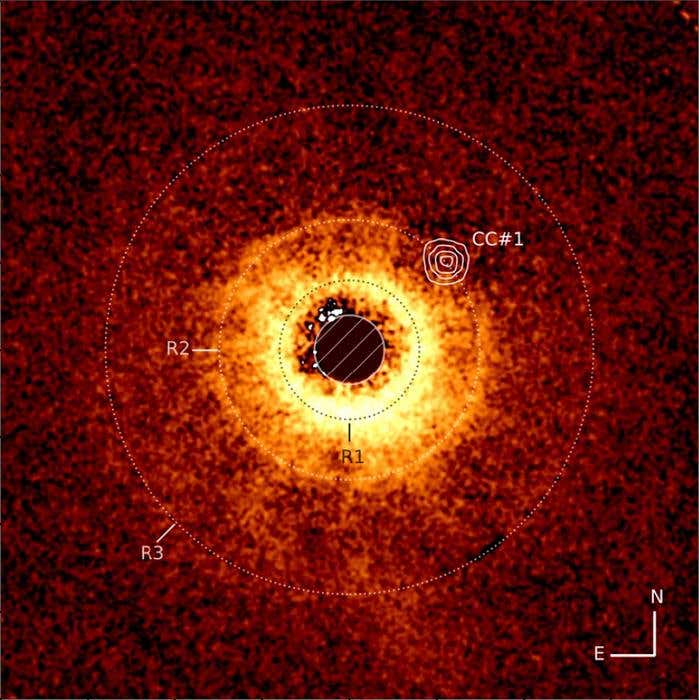Astronomers capture the first direct images of hidden exoplanet using JWST
The James Webb Space Telescope has captured its first image of a small, cold exoplanet hidden in a debris disk. Scientists believe this marks a new chapter in exploring worlds beyond our Solar System.

Webb telescope finds a Saturn-like planet hidden in cosmic dust, opening a new path to study young exoplanets. (CREDIT: JWST/ESO/Lagrange)
The James Webb Space Telescope has captured an exoplanet no one had seen before. This marks a turning point in space exploration and opens up a path to finding small, cold worlds far beyond our Solar System.
The Search for Hidden Planets
Scientists have always looked for exoplanets to learn how planetary systems form. Exoplanets orbit stars beyond the Sun, and their study gives clues about our cosmic past. Thousands of these planets have been found through indirect methods. But direct images are rare because exoplanets are dim and hide in the glare of their stars.
Researchers at the Observatoire de Paris-PSL, working with Université Grenoble Alpes, used a new tool to overcome this challenge. They attached a coronagraph to Webb’s MIRI instrument. This coronagraph blocks the star’s light, much like the Moon blocks the Sun during an eclipse. This made it possible to see faint objects around bright stars.
Published in the journal, Nature, they found a new exoplanet located in a disk of rocky debris and dust. This planet, named TWA 7 b, is the first discovered by Webb using direct imaging.
Rings and Clues in Cosmic Dust
Most planets form from dust and gas in swirling disks around young stars. Over time, gas escapes, leaving behind debris disks made of rocky fragments. These disks can last from a few million to a few billion years. They often show rings, gaps, and empty spaces that hint at unseen planets shaping them through gravity.
The star TWA 7, about 34 parsecs away, has such a disk. It is only 6.4 million years old and belongs to the TW Hydra association. Its disk shows three main rings, seen from above. The innermost ring lies at 28 astronomical units (AU) from the star. A very narrow ring sits at 52 AU, and a broad outer ring stretches to 93 AU.
Scientists had suspected that hidden planets caused these rings. But before Webb, imaging tools could only find planets at least two to ten times the mass of Jupiter. That changed with Webb’s mid-infrared sensitivity.
Related Stories
A Breakthrough Image
On June 21, 2024, Webb captured coronagraphic images of TWA 7 using its F1140C filter, which observes at a wavelength of 11.3 microns. The team compared these images to reference stars to cancel out light distortions. The final images revealed three bright spots near TWA 7.
One was a background star already known. Another looked like a distant galaxy. But the third source, about 1.5 arcseconds northwest of TWA 7, was different. Its location matched the narrow ring seen at 52 AU, and it had no match in previous data.
The scientists ruled out that it was a Solar System object. Even distant dwarf planets like Sedna show movement over two-hour exposures, but this object stayed still. Its lack of motion suggested it was not a background star either.
They also checked if it could be a distant galaxy. The chance of finding such a galaxy at that exact spot was only 0.34%. Combined with its position within the ring gap, this made the galaxy theory unlikely.
Confirming a Planet
Using the HADES model, which studies planetary atmospheres and evolution, scientists estimated the object’s temperature to be between 305 and 335 Kelvin. Its mass was about 0.3 times that of Jupiter, similar to Saturn. Models showed that such a planet would create a thin ring and a void exactly where Webb saw them.
Further N-body simulations backed this up. They simulated 200,000 rocky bodies orbiting TWA 7 along with a 0.34 Jupiter-mass planet. After six million years, the planet’s gravity carved out a narrow ring at 52 AU and left a gap where the planet orbits.
“The similarity between the TWA 7 disk image and the simulation is remarkable,” the team wrote. This match in theory and observation strengthened the case that the object is indeed TWA 7 b.
Looking Deeper into TWA 7 b
This discovery is exciting because TWA 7 b is ten times lighter than any exoplanet seen before with direct imaging. It is not a giant like Jupiter but a smaller, colder world.
Its low temperature, around 320 Kelvin, makes it an ideal target for studying non-irradiated gas planets. Unlike Jupiter, which reflects a lot of sunlight, TWA 7 b glows mainly from its own heat. Comparing its atmosphere with Saturn or cold planets like eps Ind Ab could reveal how these worlds form and evolve.
Scientists believe Webb could find planets even smaller in the future. This could include planets with just 10% of Jupiter’s mass.
How Webb’s Tools Made This Possible
The key to this discovery was Webb’s mid-infrared instrument and its French-made coronagraph. By blocking out the star’s light, the coronagraph allowed astronomers to see faint heat emissions from the planet.
Researchers took four hours of data on TWA 7 and compared them to a similar star to remove light noise. They then used computer models to confirm the planet’s temperature and mass.
The coronagraph’s success shows the importance of new tools in astronomy. Without it, the faint glow of TWA 7 b would have been hidden forever.
A New Age for Exoplanet Research
This finding proves that the James Webb Space Telescope can detect much smaller exoplanets than before. As technology improves, you might soon hear about planets that are even more like Earth.
Future telescopes will use even better coronagraphs to search for worlds beyond our Solar System. Scientists have already chosen promising targets for these missions.
In the words of the research team, this is just the beginning. The path to finding other small, cold planets is now open, and each discovery brings us closer to understanding where we came from.
Note: The article above provided above by The Brighter Side of News.
Like these kind of feel good stories? Get The Brighter Side of News' newsletter.



